|
May 1, 2007
Wildfires
and Forest Life
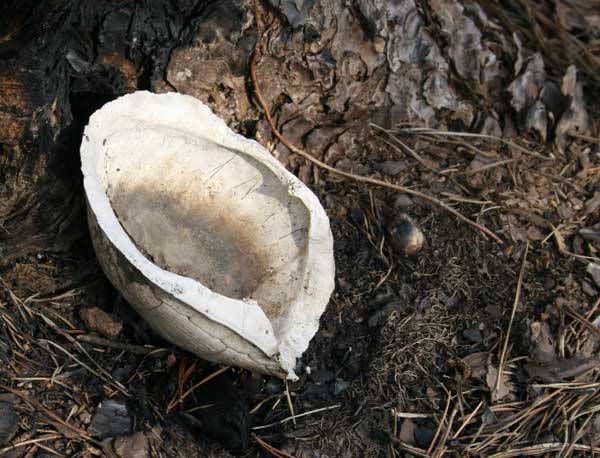
Scorched earth, forest floor after
wildfire. Cumberland Gap National Historical Park.
(*photo
credit)
At the beginning of May we
celebrate "Be Kind to Animals and Wildflowers Week." One way to
show this kindness is to preserve the habitat of the wild flora and
fauna with which we are blessed. Without a healthy habitat these
plants and animals cannot survive. An earlier essay, "Forest Fires"
(August 5, 2006), mentioned human residences in forested areas and
the problems associated with human impacts caused by arsonists and
careless visitors. Threats exist. However, somewhat overlooked was
the impact on individual wildflowers and wildlife that inhabit these
threatened areas. Without forest cover these plants and animals
cannot survive and flourish, as experts are quick to tell us.
What must we do beyond
preventing forest devastation? For one thing, we should strive to
experience the woodlands through hiking, provided we do so in a
non-polluting manner. We could "walk the woods" through a written
travelogue or through photos or a motion picture or the Internet --
a virtual tour. What we come to appreciate should take us one step
farther to a growing concern about our wildlife. Let's take the
second step of learning about the major threats to woodlands. When
we realize that off-road vehicles can smash some very rare wild
orchids, we are moved to take steps to stop them. The same holds
true for misplaced timber harvesting and other forms of so-called
development and human operations that impact wilderness.
What becomes evident is
that a wildfire can suddenly cause immense damage to woodlands.
These fires come quickly (either by human cause or by lightning),
and burn too fast for animals to find means of escape by burrowing
in, flying away or escaping on hoof. From what I have experienced,
forest fires are terrifying, unpredictable and, once started, make
us feel quite powerless. They destroy far more than the trees
themselves. The biotic life is highly disturbed and, with the
exception of a few plants and animals that have adapted to frequent
fires, many species are wiped out in the fire-damaged area.
The serious danger of
wildfires during this growing season makes us seek measures to
reduce their impact: minimize campfires in the woods and never leave
them unattended; promote adequate police protection of forestlands;
report infringements of existing regulations; cease outdoor burning
when that is forbidden; stand up for the expansion of protected
wilderness areas and support the limiting of human activities in
designated areas; halt wildflower, ginseng, and wildlife poaching in
both public and private woodlands; encourage the reintroduction of
species in burnt-over territory; and plant trees in burnt over and
heavily deforested regions. Certainly no one of us can do all of
these things, but at least we can plant trees as an initial gesture
of concern. In this way, we show respect for the wildlife that live
in these fragile areas -- and we can do so as an act of kindness to
the wildlife struggling to survive there.
May 2, 2007
Going "Cold
Turkey"
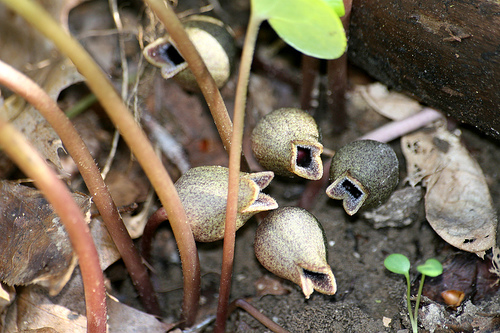
Little brown jug, Hexastylis arifolia
(*photo
credit)
The expression "going cold
turkey" (gct) refers to changing one's practices without using
medicines or medical services. With tobacco addiction, "gct" refers
to refraining from using nicotine patches or gums or certain
medicines in order to break with the addictive habit of smoking.
Some tobacco people say, "If you want to quit smoking, consider
chewing." They hold that certain smokeless tobacco products are less
harmful than others and that these contain far fewer milligrams of
cancer-causing nitrosamines. But chewing or snuff taking are
temptations that do not address the basic addictiveness of tobacco.
In fact, recent research has found that cold turkey is more likely
to result in remaining abstinent than is taking nicotine-products,
which are not really coming to terms with addictive behavior.
Actually more people
experience "cold turkeyhood" than is at first imagined. When people
are hospitalized or imprisoned, they no longer have access to the
abusive substances. In federal prisons today the inmates are not
permitted to smoke and so they have gone cold turkey whether they
want to or not. Sometimes the process involves the suffering
associated with withdrawal, but that is not life-threatening (as is
the practice of smoking), only somewhat painful. In an age when
many have little tolerance for pain, this cold turkey process
becomes a monumental event. But in the entire order of things, the
pain of "gct"is little compared with the suffering of a smoker
undergoing cancer treatment and the terminal stages of lung
cancer.
Coupling the process of "gct"
with unfamiliar or pleasant alternative events can be one practical
way to effect success. I broke with smoking by taking a trip out
west with non-smokers in 1983, and the unfamiliar landscape and
mountains helped alleviate the pain and reenforce the new
tobacco-free habit. My suggestion as one who endured this
thirty-five years ago is to break clean and to do so with the
assistance of others who do not smoke. This is meant as advice both
for smokers who are trying to quit and for those setting up
conditions for encouraging their smoking friends to break the habit
once and for all. In fact, a gradualist approach of using patches
or gums or chewing tobacco is a non-verbal communication to the
addicted person that the caregiver does not believe the smoker will
stop.
Amazingly, I have found
that quite a number of people who are receiving medical treatments
for smoking-related diseases will not quit even in terminal stages.
When they are gently quizzed as to current practices, they say that
it is too late, or that terminating their practice will not help.
"Why stop now?" Besides, they find the smoking habit is a valuable
crutch now, as it has been for some time while their health has been
gradually eroding. A combination of denial, justification, and pure
addiction stares them in the face. Far better to target those who
are still in good health as the prime candidates for going cold
turkey. Good luck on your efforts.
May 3, 2007
Ministry of
Healing

Unintentional
terrarium, developed inside old bottle left behind the in the
forest.
(*photo
credit)
Ministry is doing something
of service for another. Our Earth is not a paying customer apart
from the priceless gift of natural beauty that it gives to each of
us. Ministry in healing our troubled Earth is a payback, something
that we owe to the planet, not an opportunity to make money off a
sick victim.
Care-giving has now become
so institutionalized that one might expect that the caregiver needs
a certification, degree, certificate, and on-going educational
experience in order to be an "earth-healer." I suspect one way is
to invent the title Doctor of Earth Healing and to have an
educational enterprise confer the "DEH" degree for some sum of money
to all who feel the need for a doctorate in an emerging field.
Wouldn't that be a racket that many could see through, like
commercials for obtaining a degree for a 'few hundred dollars? I
recently received a computerized bill from a therapy center I had
never heard to be paid instantly to the amount of "ALBERT" and
wondered who the poor computer puncher was who developed such an odd
billing. I discovered there were over forty thousand such mistakes
with that one billing. Misplaced professionalism is not healing;
instead, it makes us sick.
In what does this new form
of healing ministry consist? As with healers who direct their work
to human beings, Earthhealing involves a number of characteristics:
awareness and compassion for those who hurt (even beyond the human
sphere); patience and effort required to understand what is
happening; knowledge and creativity in formulating remedies based on
the best experience; willingness to get one's hands dirty and not
just expect others to do something; enthusiasm to assist in bringing
others into the healing ministry; and hope that ultimate victory may
be obtained.
Each of these
characteristics is worth pondering and is found in the course of
reading "Eco-Spirituality through the Seasons" on this website.
Awareness means that one does not deny the reality of environmental
degradation and the phenomenon of global warming and climate
change. Compassion means that we suffer vicariously and strive to
assist all victims -- flora, fauna and especially people
(eco-justice is one with social justice). Listening and learning
means that we must take the time to understand the emerging
sickness. And the result must be a down-to-earth spirituality that
impels us to become involved without excuse or seek to escape from
the work ahead. Enthusiasm is contagious and thus we need to
inspire others to join us as Earthhealers, for the task is too great
for just a few hands.
Victory can and must be
obtained for the sake of the family of all beings. We are one with
others and in that oneness we desire to see continuation of
planetary life in all its forms. We do not want to see extinction,
whether it be cultures and languages or endangered plant and animal
species. We are confident that today's trends can be reversed --
but it takes a living hope to bring all this about.
May 4, 2007
Two Faces of
Kentucky

Tree oddity, a large gall near breast height of a
tree.
(*photo
credit)
This weekend is the famous
Kentucky Derby and the Queen of England is going to be in
attendance. She likes our Commonwealth and has visited it at
certain times to enjoy the hospitality of Kentucky horse people. I
guess she knows the Bluegrass State quite well and even feels
comfortable here. This makes us reflect on that one side of
Kentucky -- the side of wealth and affluence. We are aware that
John Kennedy and Lyndon Johnson also came to the Eastern portions of
Kentucky to squat on porches and talk to those who were beset by
poverty. How could one area (and ours is among the lower third in
size among the fifty states) have such contrasts in such relatively
short distances of less than one hundred miles?
The Queen is arriving and
going up to our "golden triangle" of
Louisville-Lexington-Northern Kentucky, where much of the wealth is
concentrated. The triangle is not really "up," for topographically
all portions of that area are downstream from the highlands and
headwaters of the Licking and Kentucky Rivers. The "up" refers to
social status, and this is still a very status-conscious state. The
flag of the Commonwealth has a pioneer with a coonskin cap standing
and facing a stately aristocrat in a business suit; they are
shaking hands. Under this is a motto, "United We Stand." Well, yes
to some degree, but standing has different meanings and it needs
further definition so that all people share in the resources of a
particular place -- but some have a greater standing than others.
I think the founding
fathers of our country would find the social divisions in our noble
state as being hard to visualize at the start of the 21st century.
But in retrospect, it may be an honest microcosm of our world. We
have a divided world and the status symbols tell of a deeper reality
-- of people who strive to entertain the wealthy and notable and
seek to shut out the poor and shabby; of some who have the best and
the greatest and others who cannot afford health care; of some who
live in splendid retirement comfort and others who must work sixty
hours a week and don't dare object for fear of losing their jobs.
Kentucky is beautiful and
has many resources that are not equally distributed. Though a fair
share of that natural beauty has been found in eastern Kentucky with
its plentiful wildflowers and immense herds, flocks, and coveys of
wildlife, still some people do not regard this of equal value to
manicured horse farms with painted, plank wood fences (from eastern
forests) and barns. Both forests and horse farms are greenspace and
both are under attack from different forces: the former from coal
and timber operations and the latter from developers wanting to
expand housing developments and shopping centers. For us to stand
united means that we take into consideration both of these problem
areas and view them as of equal importance. Environmental solutions
are easier to tackle when we see the entire commonwealth as just
that -- a wealth that has its commons that must be respected by all,
and for all.
May 5, 2007
The Horse
Culture
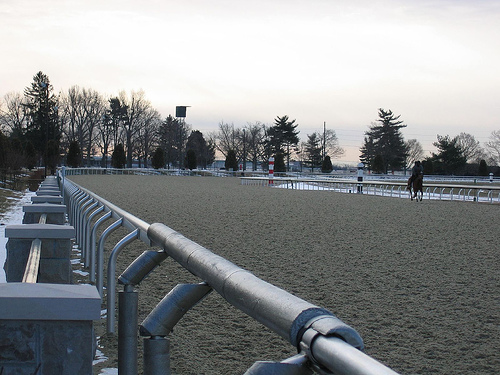
Thoroughbreds in the early morning light
(*photo
credit)
Every year on the first
Saturday of May a Kentuckian's fancy turns to horses. Horses are
and have always been a part of our culture. I grew up on a farm
with horses but they were the plodding work type except for "ole
Babe" who was a retiree allowed to be ridden by us youngsters. Babe
was my grandmother's gift to my dad, and I will never forget his
grieving when the horse passed at a ripe old age of thirty.
The Babe story could be
replicated frequently in our Commonwealth. I recall the more
aristocratic riding horses of our more aristocratic neighbors, the
work horse that took loads of wheat to the threshing machine, the
horses that were used to plow the fields, the horses in simpler
times that would come up to the plank fences at race horse farms to
allow the passengers of a parked vehicle to pet their noses and
offer them apples. We had the places on main street that still had
posts for reining the horses with buggies, and these posts were
often given a fresh coat of black paint. We heard tales of a
trusted horse taking the intoxicated owner back home while he
napped. We knew how horses became family members of sorts. Horse
culture, from the smell of their manure to the coarse feel of their
tails as they hit you when swatting flies is deep, very deep in our
collective memory. The rapid transfer from horse to auto culture
came at a great price.
I guess all these
remembrances of our horse culture hit us harder on Derby Day. In
order to exercise a fidelity to that culture we learn the names of
Derby runners, place bets, watch the three-minute act on television,
and talk to friends about whether we chose the winner to friends on
Monday. A number will actually observe the event in person (see
yesterday's mention). It is an annual event that gives us pause.
And we have a heightened sense of interest this year because of the
upcoming 2010 World Equestrian Games that will soon occur near
Lexington at "The Horse Park," a place most Kentuckians are proud
of.
Family friends, the Brodts,
bequeathed the senior Mr. Brodt's blacksmithing equipment to that
horse park -- and so a little bit of my neighborhood is present
there. When I see buggies and horse drawn farm equipment in museums
today, I know that I am a senior citizen -- especially since we used
these types of museum pieces in my early work-horse years. For
some, these pieces being displayed seem ancient, but for many of us
they were integral parts of a culture that seems at times to be
fading. In fact, some friends such as Wendell Berry still use work
horses, though I for one did not really like to work the horses, or
even to become an accomplished horse rider. But even without that
personal touch, every Derby Day I do recall the horse age, when
during the busy work day we would pause to let the horses get their
wind. It was a slower time and one that is missed by the modern
get-up-and-go culture. Horses gave quality to our life, and on this
day I put that "gave" into the present and future tense. May that
culture continue with us.
May 6, 2007
Renew!
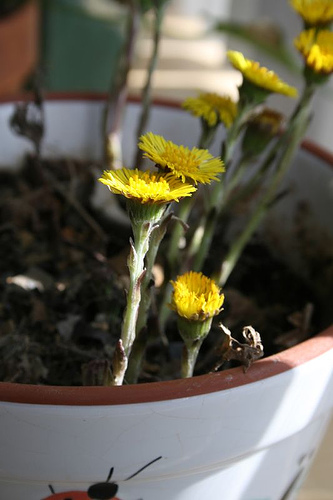
Resident
aliens, transplanted coltsfoot (Tussilago farfara)
(*photo
credit)
Declare this with cries
of joy and proclaim it,
and send it out to
the ends of the Earth.
(Isaiah 48:20)
No one of us is condemned
to remain in the rut that we helped to create for ourselves.
"Renewal" is a word that comes back to haunt us time and again
because the first time we said it we thought all would become new by
merely speaking. All can never be new, for the old is deeply with
us -- and in some ways we ought to be thankful for we have much of
that history within. But to renew is to enter into a metamorphosis,
or change to a new form like a tadpole to a frog. Amazingly the
transformations in nature are often dramatic, such as when seed
grows to seedling and then to mature plant. As we watch this growth
occur in nature, we become aware that we undergo change, and we are
expected to change most dramatically within the spiritual realms
where our destiny lies.
As we know from St. John's
Gospel, peace is God's gift to us. This means that we receive a
gift of loving peace even though we may fail to see it as
transformative. In this Easter season when we celebrate new life,
we recommit ourselves to peace, a peace that cannot remain dormant,
a hidden treasure. If left unused it will tarnish. Rather, the
gift of peace can become spiritually transformative; we can become
a new person in the Lord, and we see that this can empower us to
become public, to go out of ourselves.
One aspect of renewal is to
see all others as part of our own family. What affects us in our
local community with its joys, sorrows and concerns is also meant to
reach beyond the narrow confines of our local community. So often,
we allow others to define the narrow limits of our concerns and make
us turn either within ourselves or within our immediate
surroundings. Renewal may mean just what the call of Isaiah is
saying -- declare it, proclaim it, send it out. And what is this
"it" except the Good News that we are set free? We realize that
this divine gift of peace is truly something new and something to
declare and proclaim.
We are to change a world
that thinks in terms of conflicting parties and policies to one of
seeing all people as part of the human family. Hurt touches us
all. What makes someone else cry and suffer begins to make us all
cry and suffer. And what brings us individually the joy of God's
peace is something that must be shared with all other members in the
human family. The process of renewal is not just a metamorphosis
that stops at the individual subject. As part of the human family
my renewal is our renewal, a contagious internal action that does
not stop within, but touches those near and then others and others.
Today, the call is to renew our lives in this high springtime of
2007; we are coming to realize that this is not a private matter.
We are one human family and the gift of peace is to be shared among
all. Renewal is meant for the whole world even when it starts
within you or me. In today's world this peace cannot rest within;
it must go out to all the ends of Earth.
May 7, 2007
Some Reasons
to Emphasize Herbs
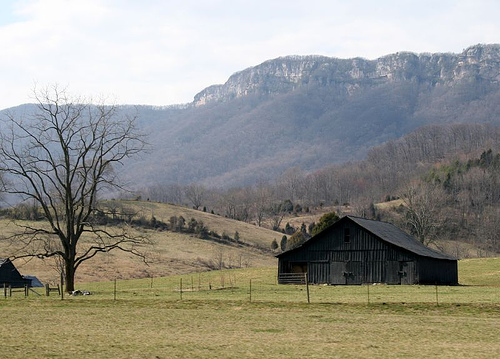
Cross the heartland. Weathered black barn against a
backdrop of the Appalachian Mountains.
(*photo
credit)
Again we celebrate National
Herb Week, and this becomes a good opportunity to say something
about gardening once more, for herbs are garden plants and deserve
promotion:
* Herbs grow easily without
any extra effort and can be raised organically quite easily. I find
that the mint I started last year only needs to be controlled --
not coaxed to grow; and in early spring it is starting to supply
fresh herbal tea leaves for the next seven months of this year. If
one could add this up it could be shone as to be an economic bonus
as a substitute for coffee.
* Outdoor herbs can
enliven the flower beds and garden in general with many of them
dissuading insects of various types and serving as a natural pest
retardant.
* Many healthy herbs can be
taken indoors when frost comes in the autumn, and the potted plants
can give a good scent and furnish sprigs for embellishment of dishes
throughout the winter period. They can enliven the indoors as much
as they did the garden.
* Herbs come in such
variety that they teach us to strive for variety in the garden plot
and in the extra space throughout the yard. Some herbs like sun and
some shade, and so a little prior knowledge of where to plant is
important. Give each its proper place.
* Herbs can be dried easily
and used throughout the year for cuisine flavoring that we have not
tried before. And when researching old recipes, we find the names
of herbs that we know little about, leading up to expand our garden
varieties. And who knows, with a new herb every year we could be
herb experts in a few decades. I have grown a dozen varieties but
should have been at five dozen by now.
* Once sprouted, herbs
seldom disappoint us. They prove quite dependable and can withstand
drought, heat and rainfall. They are often able to endure when
veggies have hard times.
* Many herbs have age-old
medicinal benefits but, except for parsley and poke, I hesitate to
recommend them. These herbs have a long medical history that can
prove interesting, but we realize that some can be overdosed just as
can commercial medicines. And without a knowledgeable account of
these various herbal cures, we could be on a slippery slope to
causing readers to over-consume.
* For the most part, herbs
are gentle plants and prove good companions to other plants both
flowers and vegetables. Basil and parsley grow well next to
tomatoes. There are exceptions, for fennel does not like other
plants, and from personal experience I know that others do not
thrive near fennel -- no matter how much I like its taste when
gathered. Let's hope we learn still more about the wonders of the
herbal world.
May 8, 2007
The
Hermitage Experience
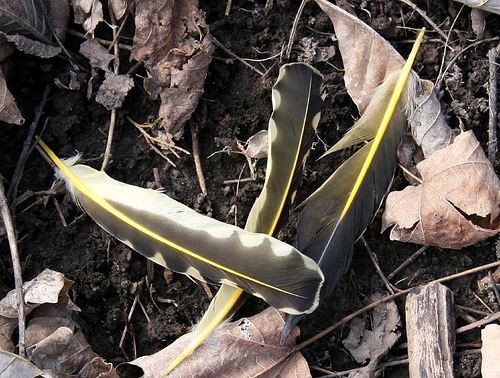
Evening
grosbeak (Coccothraustes vespertinus) feathers
(*photo
credit)
Many people desire to get
away from noise and congestion, and thus are looking for places to
go for a short period of relative isolation. They often prefer a
wilderness that is close to nature and that is subject to the least
possible disturbance. Some will find this an inviting experience
and remember it for a long period as "just what the doctor
ordered." Others may desire a slightly more inhabited or civilized
place in proximity to neighbors through fears of being alone at
night or during the day. Thus allowances must be made, and you may
desire a companion to be near when having a hermitage experience.
Hermitages are isolated
places generally designed for a single inhabitant but often are near
other dwellings for like-minded hermits. Hermitages were quite
popular in the 4th and 5th centuries A.D. while the Roman Empire was
crumbling. Some liken our current age to that of a crumbling
civilization, and thus the concept of a hermitage experience -- even
though for a brief period of time -- seems highly inviting.
Why our interest here?
Nature experiences are quite important for healing our Earth. The
healer needs time to reharmonize with Earth, and this cannot be
achieved simply by reading books or spending time on the Internet.
Getting out to nature is a necessity, and many do this on weekend
hikes and while on holiday. We crave time alone with God and the
Almighty's creation. Hermitages furnish possibilities for people
who aspire to become good healers and offer opportunities analogous
to ongoing professional education. See a partial listing of
twenty-five accessible cabins in seventeen different American states
in the Special Issues area of this Website. Being able to have a
hermitage experience even for a single overnight can be a godsend.
Some people expect the
amenities of home life, and these expectations may include all the
various aspects of a consumer culture: automatic heating and
cooling, water access, flush toilet facilities, cooking facilities
or prepared meals, laundry and room service, and on and on. Part of
the hermitage experience ought to be living even more simply than
someone is accustomed to and still realizing that even this
condition is perhaps better than what a quarter if not half of the
world's population lives with. So the expectations are not all met,
but what we do find has a certain purifying effect upon us, for we
can learn to appreciate what our culture so often takes for
granted.
Some of the listed
hermitages such as established retreat centers are near food
services, and others are more rustic. Choose wisely. A possible
hermitage exercise includes calculating how much of the world's
resources that we normally use could be conserved by living simply.
Another hermitage exercise is mustering arguments for living more
simply and considering how these could be presented to affluent
friends. How about designing a hermitage or assisting another in
building one?
May 9, 2007
Constructing
a Retreat Cabin

Small
homestead, Lee County, Virginia
(*photo
credit)
Many of the following ideas
are taken from personal experience and from observing a number of
retreat cabins and hermitages in the course of performing
environmental resource assessments in various parts of the United
States:
Determining --
Some want to have a getaway that will not require considerable
maintenance. The owners cannot afford a complete second home; they
want the cabin to be very simple so they can be near nature and
enjoy it.
Siting -- If there
are choices of sites, choose one that is in a relatively isolated
place with some vista at least nearby, and one that is not too
difficult to access. Even if materials need to be packed in for the
last several hundred feet, consider not allowing immediate
automobile access. This more or less guarantees seclusion and
privacy and discourages trespassing when the site is not used.
Planning afar and ahead
-- Construction
costs escalate if building from scratch. One solution is to equip
the site chosen with a temporary lodging in the form of a platform
on which one puts a tent for a year or so. If the site turns out to
be unsuitable for some reason, one can relocate it or double up and
use another's facility when unoccupied. When the final site proves
satisfying and a more permanent structure is decided upon, consider
and look into a variety of structures that use native materials that
are near at hand. You may prefer a cordwood building, yurt, dome,
or other structure. Some of these can be built rather quickly and
others take more time. Part of planning ahead consists of making a
basic structure at one time and completing the furnishing in a
second period.
Determining --
Consider how much solar energy for passive heating and hot water
heating (showerbags may be sufficient), some sort of water catchment
system, nearby planting and tree care, pathway siting and lighting,
and installing a compost toilet in a separate or attached building
(which could serve as a mini-greenhouse also).
Designing --
When the location and the type
of structure are determined, consider economizing interior space and
thus reducing the size of the structure to the least possible while
still furnishing basic comfort. A sleeping loft overhead is a great
space saver. Amazingly, a one hundred square-foot structure can be
spacious when properly furnished with essentials only.
Furnishing --
Generally the best economy of space is a walk-in prayer/living space
with easy chair, table, small sink and closet; the upstairs loft,
accessed by ladder, could have a mattress and some place for hanging
clothes and little else. When this structure is furnished with
necessities, it will be a welcoming place to come and spend
time.
See
Healing Appalachia:
Sustainable Living through Appropriate Technology -- just
released with notice on this website.
May 10, 2007
Tree
Markings

Bench tree, possibly marked by Native Americans.
(*photo
credit)
Trees have been marked for
centuries in order to convey a message. In come cases, the Native
Americans marked trees much like road signs in order to alert
travelers to upcoming dangers or tell them in which direction to
turn. The photograph shows one of these so-called "bench" trees
that has lived for a number of centuries and still tells a somewhat
hidden story in its notation. Trees were also marked in early
pioneer days, and 18th and 19th century legal deeds will often refer
to marked oaks or other old trees as signals for boundaries or turns
in the border line. At that time with their limited resources it
was the best marking they could do.
We know that a number of
the early hunters and trappers took a cue from the Native Americans
and produced their graffiti by marking trees with their names or
some other specific signs. This is true of Daniel Boone and others,
and their tree markings are still highly prized. Even as kids, we
thought it nice to leave our marks on rocks, concrete and even trees
that could possibly endure for others to see. What moves children
and modern graffiti artists? A deeper question is whether people
get some pleasure in making a mark in public. What about the use of
this computer and this essay? Why a mark for others to see and
understand?
Leaving one's mark on the
world, in which all one experiences is like a dense forest, will
often be best achieved by something like a tree marking. It is much
like the pre-historic art found in caves. The need to communicate
runs deep, very deep. To take an idea that we know or desire to
tell and transfer this to something that is more permanent than a
spoken word is part of being human and social. We try to make a
mark that others can follow and gain some knowledge from. When the
design of the sign is as recognizable as possible, adding color and
flourish increases the feeling that the sign conveys. The
biographers note that Isaac Jogues, the Jesuit martyred by the
Mohawks in the 17th century, and his French companions marked trees
with crosses. The cross is an instrument of torture and a popular
sign of Christian faith, just as the fish was a sign in the early
century catacombs for Jogues' ancestors in the faith. The cross is
still a powerful symbol today for all who profess to be Christians.
Today, we may not have to
make signs by marking trees, but we can plant trees so as to tell
others of the need to reforest a damaged landscape. The modern
markings are the planted trees themselves. We have other ways to
communicate that are just as intelligible or more, and may last as
long or longer than the tree markings of old. The planting of trees
(and refraining from marking them) improves the health of trees that
are under considerable stress. We don't have to skin their bark.
Our love of nature will allow us to leave them in their present
condition. Maybe we should mark (post) the woodland areas so others
will not come and damage the trees that are present.
May 11, 2007
Hemp
Cultivation?

Honey locust, Gleditsia triacanthos thorns
(*photo
credit)
Everyone should be able to
change his mind occasionally and this I must do on the subject of
hemp. I once co-authored an article on why we should not promote
hemp again. But with time my opinion is changing. Maybe we need to
think again about cultivating hemp here. Consider that at one time
Kentucky was the hemp-growing center of the country, and the plant's
natural fiber and seeds have an off-quoted 25,000 uses. Realize
that hemp is being grown in many others nations at this time;
British farmers now see hemp as a way to make paper and save trees
and halt the waste of forest resources.
I remember hemp-growing in
the Second World War. Our country promoted it (after its abolition
in the 1930s) when the Philippine source was lost to the Japanese in
1942. Hemp was grown on the Archibald Church farm next to ours,
and the stalks had to be cut by hand (without mechanization at that
time) and "shocked" like corn stalks until dried for the mills. For
years after this growing spree, the wild hemp would cover the
roadsides -- a cheap smoke as a substitute for its cousin
marijuana. And the relationship was given as the reason it is
illegal, for hemp is difficult to distinguish from marijuana from a
distance. Actually, it was first forbidden in the early part of the
20th century, not because of drug concerns, but because it was
competing with new synthetic fibers including DuPont's Nylon.
Whatever the reasons, the illegality of cultivating this proven
natural fiber and source for protein and other good things stands on
very flimsy ground. Some come into the Commonwealth to promote the
growing of hemp again, find a few radical supporters, and get an
article in the local newspaper, but hemp production remains banned.
Two reasons for my initial
opposition to renewed hemp cultivation turn out to be easily
refuted. The first reason is confusion with marijuana. This is not
a major problem. Any hemp-grower as opposed to the "pot" growers
would be quite public, and anyone could check the cultivating and
harvesting activities of growers. Don't expect neighbors to remain
silent if pot and hemp are mixed in a field -- not in Kentucky.
Besides, pot growers would not want hemp contamination. The second
reason is that the "slave labor" due to lack of mechanization
practiced in the past would be replaced by a massive mechanization
of cutting and drying machinery, which would allow only the big
growers to perform the operation. But most of agriculture is
witnessing this major mechanization today -- and one answer is joint
community machines that can be shared or rented as has been the
practice with other agricultural machines.
These weak objections
should not stand in the way of the possibility of replacing
synthetic fibers with natural fibers. The market exists; farmers
need added income; hemp is ecologically friendly; little is
required in commercial pesticides and fertilizers; and the history
of an "early start" does favor a return to hemp. Yes, the time for
hemp has come.
May 12, 2007
Migratory
Birds
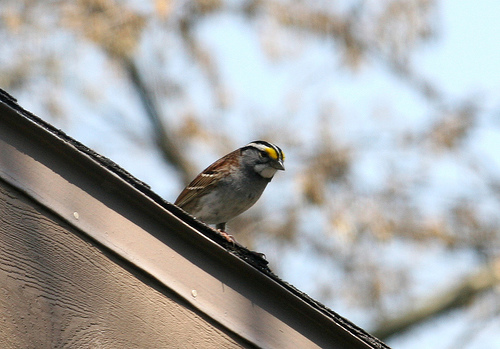
White-throated sparrow, Zonotrichia albicollis
Winter resident in Kentucky from mid-October to May. Breeds in wildlands with coniferous
or mixed
coniferous-deciduous forests, mostly in Canada and the far
northern U.S.
(*photo
credit)
Many Western hemisphere
species of birds migrate each year to warm winter homes in the south
and then back to here in summertime. A majority are songbirds but
some are shore birds, raptors and waterfowl. Most of us are aware
that the cliff swallows of San Juan Capistrano, California, return
to the Mission each year around March 19th and depart around October
23rd -- a 5,000 mile trip to Argentina. This feat is not unique,
for an estimated 350 species are migrants, all to abundance of food
-- flying insects, fruits and nectar. One expert volunteer counted
over 200 varieties of birds passing through or residing near the
ASPI Nature Center at Livingston, Kentucky, in one springtime
alone.
Other bird species are more
permanent and remain around us year round. We may expect that both
migratory and non-migratory birds could have difficulties with our
changing and troubled world. Those that migrate see resting places
diminished through development, and thus they are less protected in
crucial times when they are on the road from one destination to
another. Furthermore, their wilderness end points may be undergoing
changes, and thus they must make major adjustments on either end of
the route. Being "migratory" they are more able to move about even
when some habitats become damaged. The birds that remain also have
adjustment problems, but are better able to avoid fires and floods
than many less mobile land-based wildlife.
Though birds are more
mobile, still those who count birds report declines in population of
various species due to the damage and destruction of either terminus
or the resting places on the route itself. However, those who know
from previous bird counts tell us that a number of species are in
decline, though hopefully that is a temporary matter. The experts
cite not only the paving over and destruction of habitat but also
the presence of pesticides and herbicides that reduce the birds'
food supply and often kill the birds themselves. One development
that we would hardly expect is that shade coffee-growing tracts in
Latin America have been replaced by "sun" coffee plantations and the
latter are home to far fewer birds. The shade had proved to be a
food source and habitat for some of these summer bird species that
we easily recognize.
Migratory birds are
regarded as a key indicator of the health of our environment -- like
the canary in the coal mine. They give us a true sense of spring
with their arrival and gladden the hearts of all after winter's
drought in birdsong. And their appetite is especially voracious
since it does take effort to travel such distances, and our part of
the country is a major flyway. Just as our major highways need rest
stops, so do the flyways for the migratory birds. We customize
nests for bluebirds and those for the Carolina wren; so we should
make somewhat more generic resting places where birds are able to
feed and not be disturbed by cats and other aggressive species.
They need a quiet temporary lodging that is chemical free, and such
lodging is the most hospitable deed we can do for them. Let's hope
they can continue to pass through.

Mother with hand-sewn quilt, "Bow-Tie" pattern
(*photo
credit)
May 13, 2007
HANDS
OF APPALACHIA
Al
Fritsch, S.J.
Patty cake in new life lease,
reach for young hands soft
as fleece,
both outstretched to catch
the geese,
always moving in a play's
release.
Hands of gesture, joy
increased,
drumming hands at a dancing
feast,
swirling, whirling, time's
own yeast,
till fiddlers in the wee
hours cease.
Welcome hands, beckon the
meek,
signing hands when one can't
speak
holding hands at love's
first streak,
tear-soaked when all hopes
turn bleak.
Work life makes its mark on
all
wide or narrow, large or
small,
calloused hands, stamp a
miner's call,
scarred hands, uncover a
sudden fall.
Diamond rings no better adorn
tell -tale hands poor widows
scorn,
which picked beans and
shucked corn,
tucked shyly under an apron
torn.
Aging grace needs to unfold.
hands fever -warmed, good as
gold,
beckoning the kinfolks'
hold,
shriveled hands that'll soon
turn cold.
God give us strength, renew
this land
where pioneers plowed, and
Indians ran.
Let clinched fist be forever
banned,
offering instead a helping
hand.
May 14, 2007
What's
Wrong with Billionaires?

Dame's Rocket (Hesperis matronalis)
(*photo
credit)
I am using the same title
of an essay by Arthur C. Brooks that appeared in the March 19, 2007,
issue of the Wall Street Journal. Believe me, the contents
and our conclusions are vastly different. Brooks begins by noting
the expansion of the emerging billionaire community to 946 this
year. He tells that the New York Times says that one of
these super-rich people (Larry Ellison) has to spend $183,000 an
hour constantly to keep from growing all the richer. The author
apparently wants to calm the alarm that many of us have over this
gigantic sweeping of the commons into the hands of a few -- even
though the company of this elite few grows by the tens or fifties
each year. The essay goes on to tell how these super-accumulators
are also super-givers and that there is satisfaction in such
charity. What is never discussed is that this giving is a power
play and that this, like the greed to accumulate, is something that
gives a certain transitory satisfaction as well. If one is not
beholden to the people to whom the commons belongs, but can make
decisions on who is to benefit from the wealth acquired, this
becomes a subtle exerting of power. Guess who decides who
benefits? Someone who dares question the largesse is going to
receive few benefits from the super-giver.
To answer the question --
there is nothing inherently wrong with billionaires as such.
Assuming they made their wealth in a "legally acceptable manner," it
is not for us to cast judgment on their money-making skills.
However, many of us still hear the words of Jesus about the chances
of the wealthy getting to heaven as less than that of a camel
passing through the eye of a needle. And he did not live in an age
of billionaires. Retention, not acquisition brings on consideration
of this dire prediction. And even their retention of wealth is not
their own fault as such. Is it not we citizens of our nation and
our world who have allowed the commons to be taken over by these new
nobility and have allowed them to acquire, retain, and dispense this
immense wealth to their own satisfaction? Power has been granted to
them through the ignorance, indifference or false understanding of
what is the "commons" or the wealth of all the people, whether
expressed in land, money or natural resources of any sort. We have
given to them the power, mainly by not taxing their billions for the
common good; and we are to blame.
Some of us, like many early
Americans, still oppose massive wealth. Many of us are against the
divine right of kings. But are we also against the divine right of
billionaires? We allow them to continue in their condition (whether
of happiness or misery) without doing anything about it. As far as
their acquiring goes, that may even be laudatory if they put many
people to work through their prospering businesses. What we are
challenging is their political/social/economic power to retain and
exercise that wealth to their own choosing. This is wrong in every
sense of the word. Benjamin Franklin attempted to insert a
restriction on excessive wealth in the Pennsylvania constitution,
but failed. He would have been shocked at the vast accumulation of
wealth in today's world.
May 15, 2007
The Glory or
Fate of Coral Reefs

Bird's nest in cradle of tree
(*photo
credit)
I am a news junkie and have
been so since I was eight years old in post-Pearl Harbor 1942; I
would hurry home to read the newspaper to find out whether the
British Eighth Army had stopped Rommel's Panzers before the Suez
Canal. And Tobruk held firmly, and the terrible war began to take
on a more optimistic note. From that early age until this year,
that state of being a junkie continued, but I must confess that it
has ceased now. The book, Coral: A Pessimist in Paradise by
Steve Jones does little to allay this current condition. And I
mention this here a week before Biodiversity and Maritime Day.
I have never experienced a
coral reef through snorkeling or other means and so am limited in
such observations. All I know of coral is a chunk that appears in
certain aquarium web sites, or the photos in "National Geographic"
with coral formations in a blaze of glory and color. We hear that
the Great Barrier Reef off the eastern coast of Australia is the
only biological structure that can be seen from space. We know that
other continents are also blessed with coral in some form or other.
What is evident is that there is an immense area of beauty that many
of us less traveled humans have not yet laid eyes upon.
Jones defuses the vision of
sugar plum corals to talk about how these areas of maritime life
have been subject to the vicissitudes of other disasters and
catastrophes. And his pessimism spills over into other related
subjects as well. Coral has always been part of the history of our
planet and the scientists tell us through core drilling that the
buildup is like the rings of a tree, each dating various events in
the coral's extended growth. Many coral reefs are now in serious
trouble, and the massive flowering of the beauty of these living
structures is now meeting death through pollution and the
consequences of global warming. Is this the final growth layer for
many of these reefs? Some students of coral life would say so. Is
the minute addition of each living depositor that contributed to
building the coral structure over long periods of time now in vain?
Are we to await the inevitable death of coral in many parts of the
world?
Is there any good news when
it comes to coral? Unfortunately, I am unable to discover any.
Jones says that "human ingenuity revealed the intricate workings of
coral reefs, but it has also spelled their ruin." My only fear is
that it may not be too late. Recording the beauty of corals should
encourage all of us to redouble our efforts to halt pollution of our
oceans and the global warming effects we are beginning to observe.
Maybe the coral is the record of things past that must be preserved
as living evidence of what beauty God has wrought. To accept
coral's doom is to accept the deterioration of our planet -- and we
must not acquiesce to this. Coral stimulates within us the impulse
to take charge of the fate of our Earth and change it for the
better. It is not too late and we must not let pessimists have the
last word.
May
16, 2007
Biking
Benefits
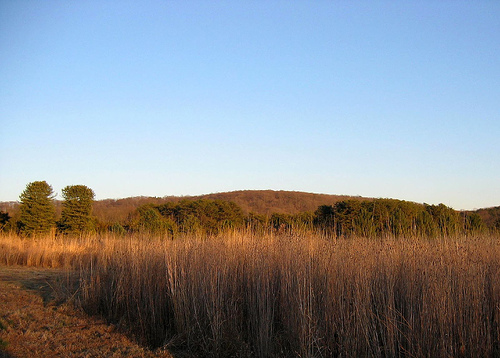
Prairie near sunset, Bernheim Forest and Arboretum
(*photo
credit)
We have discussed bicycling in the past on "National Bike to
Work Day." In highly congested regions and in places with
narrow roads with some truck traffic, this can be dangerous.
However, apart from these safety precautions, one must again cite
the advantages of increased bicycle use in commuting to schools and
places of work. We notice that high schools today have very
large parking lots filled with cars driven by the juniors and
seniors, now able to drive and living not far from the schools.
It is the thing to do. The same holds true for those workers
who live up to a few miles from their place of work. Consider
how many of these workers and students would be so much better off
if they biked not just for one day but as a routine? Maybe not
all could do this, but a large number could and would receive many
benefits in return:
* Physical exercise -- First, remember that biking is good
exercise, something that many workers and students lack due to the
culture in which we find ourselves. Modern students are often
driven right up to the door of the gym. Biking gives us fresh
air and full spectrum sunlight as well as tone to muscles and
control on our weight.
* Energy conservation -- Biking takes muscle energy of which
we normally have an excess, and saves on automotive fuel, which is
becoming increasingly scarce. Let's not forget that each of us
contributes to the heavy drain on the limited world supply of
petroleum, and every little bit of conservation helps.
* Good ecological practice -- Biking to work is a green
means of transportation. Why not stop air pollution when we
have an opportunity? So often the auto trip to work could be
avoided in favor of non-polluting walking or biking. Each of
us must make this decision, which is in part determined by the
location of our residence, travel route, and our personal health.
And the choice for biking is one for the health of our neighbor as
much as for each biker.
* Sound economics -- Biking is economical, for a bike mile
costs very little except the amortization on the equipment, which
costs only a fraction of what an average automobile costs.
Tires cost less, maintenance is virtually non existent, and, all
around, a bike proves beyond a doubt to be the cheapest way to
travel more quickly than walking.
* Improved outlook -- Those who go outdoors at virtually any
time of day return and have a fresher approach to the work in which
they are engaged. The break relieves stress, improves the
entire personal psychology, and ultimately allows for better social
relations. Biking as an exercise allows for the same
"break" like conditions and allows for a fresh start.
How about observing a Bike to Work Day today -- that is for
those of you who do not work where you live?
May
17, 2007
The
Trusty Hound Dog

An old friend on the farm, Boyle County, Kentucky
(*photo
credit)
I
only had the companionship of one hound dog in my life and will
testify to his immense value. Upon further reflection one must
say that hound dogs (beagles, bloodhounds, foxhounds, etc.) are not
the most beautiful animals and yet they come in handy so often that
"our best friend" can be much more than just a pet (see
"Best Friends Day and Dogs," June 8, 2006). Let me
give a listing that applies to all dogs with the olfactory senses of
the best of dogs -- the hound dog.
* Hunting -- The dog was truly needed in an age when hunting
was more than a sport and was needed to help provide meat for people
surviving in harsh climates. The hound dog could sniff out a
mammal and allow the hunter much needed game for "burgoo"
(a stew composed of a variety of varmints and whatever vegetables
were at hand -- the original pioneer dish of life).
* Tracking -- The hound dog was sent out after escapees so
often in the past and even in the present that no scientific or
technical device has ever been found to equal the ability to catch a
scent and lead the law to the culprit.
* Searching -- So often people are lost in the wilderness and
the only rapid way to find the trail and keep it is a good dog. Here
hounds come in handy, along with other breeds of dogs as well.
The personal articles of the lost person give the basic scent, and
the dog keeps this in mind while hunting. This ability has
resulted in some dramatic rescues including one in North Carolina a
few weeks ago of a young missing boy scout.
Alerting --
Most dogs will raise enough so alarm that one knows when a visitor
is present. The better dog is naturally friendly and is aware
of the distinction between an honest visitor and a prowler.
That was the talent of the "dogs of war" during the days
of trench warfare in the Great War (World War I), and that is what
any isolated homestead wants from its watchdogs.
Defending -- Everyone
wants a watch dog that is not naturally vicious and yet when the
proper time arrives will defend its keepers and their property.
Just the ability not to bark and run but to stand and bark will do
much to stand in the way of an approaching hungry mammal or human
thief. And an even more welcome characteristic is the dog who
will defend all when the chips are down.
Being a Companion --
Sometimes when the weather is wrong and news always seem bad, a dog
knows just when to come up for petting and to show that all is not
lost -- trust and love still exist in this troubled world -- and
that's appreciated.
Beautifying --
No old hound dog ever won a beauty contest but beauty is in the eyes
of the beholder. Many mountain people would confer
"beauty" in a hound dog's ugliness and accept it as such.
May
18, 2007
Road
Rage

Pipsissiwa, Chimaphila maculata
(*photo
credit)
We are preparing for another driving season as Memorial Day
approaches. Maybe it is good for us to review our driving
habits and find out just how prepared we are for the little mistakes
and lacks of courtesy by other drivers -- or at least how we
perceive them to be, when we are tired and upset. Some now
confess road rage, something unheard of in the 19th century, though
on a rare occasion one buggy driver may have gotten irritated by
another. Unfortunately, road rage is all too frequent today,
and we hear of curses, hostile looks and signs, fights, mistreatment
of vehicles and pets, and even murders on the congested highways
today. Road rage is common, and the conditions that
precipitate it even more so. I do not often experience and
never take any pleasure in urban congestion, and I'm impatient
enough to become a public "rager," if that is the word for
it.
While working on a future book called "Sounds and
Silence," I realized that road sounds could enhance this rage,
though I am uncertain whether there are any studies on the subject.
Sirens and horns may aggravate the circumstances; the constant
drum beat of hard rock that vibrates from other vehicles as we sit
at a stop light, or the mere sound of constant traffic could put
people in the mood to be impatient and angry -- and thus willing to
take it out on the driver who busts into the line of waiting cars or
fails to give the proper signal.
One frustrating sight today is seeing folks talking on cell phones
or sending a text message while driving. Some states are
taking notice and enacting new regulations against such practices.
Instances can accumulate and blur into one when the next roadway
peccadillo is observed. Drivers' patience becomes shorter and
then comes the proverbial straw that breaks the camel's back.
The traffic stalls and comes to a complete stop, or inches along at
starts and stops for miles. Nerves fray. The next guy
says something that is taken as an insult, and so you do unto him
one better than what he did to you, and the exchange escalates
rapidly. He stops his inching vehicle, gets out and comes over
with his fist clenched. You have several alternatives:
show the nearby car drivers that you are not afraid and accept the
confrontation; roll up the windows, lock the doors and call 911;
exit by the other door and abandon the vehicle; beckon for the
passenger to take over and confront the aggressor; speak in a
mild manner and ask the approaching person to pray with you;
offer a toast; or consider the entire scene as a nightmare.
What is evident is that road rage simmers over time, breaks into the
open under certain conditions quite suddenly, can take quite
dramatic turns in an instant, and involves a pure stranger.
But
we ought to prepare ourselves, for we could be the ones who
precipitate some of the difficulties. Avoid congestion, but
when it occurs say a prayer; turn to music that is one beat
slower than your heart beat; and smile, for others will love you for
it. A good deal of humor goes a long way. At least that is my
resolve.
May
19, 2007 A
Fee for the Carbon Content of Fuels
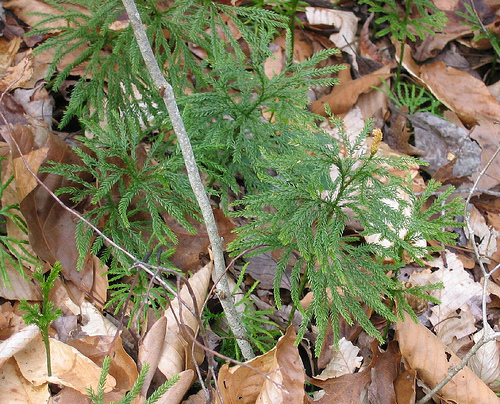
Groundpine, Lycopodium obscurum
(*photo
credit)
A letter sent to U.S. senators and representatives follows --
Given the immense scope and immediacy of the problems of global
climate change, it is necessary to employ a broad range of
strategies to significantly reduce total energy use and to encourage
the rapidly expanded use of non-fossil and non-nuclear renewable
sources of energy. The mix of policies should include much
tighter mandatory efficiency standards for vehicles, appliances,
lighting, buildings, electricity generation, and industrial
processes as well as the required use of renewable energy for
electricity, transportation fuels, and heating and cooling.
Greatly increased tax incentives to encourage the use of energy
efficient and renewable energy technologies as well as much higher
levels of funding for research, development, and -- particularly --
procurement and deployment of sustainable energy technologies are
also needed. In addition, however, some form of user fee based
on the carbon content of fuels is essential.
A carbon fee is arguably the most transparent, universal, equitable,
understandable, and immediate way to internalize the true
environmental cost of consuming the fossil fuels that contribute to
climate change. Such a fee is also relatively easy to
administer and makes the best use of the marketplace to encourage a
rapid shift in energy use away from coal, oil, and gas towards more
energy-efficient and/or renewable energy sources.
We recognize the concern that such a fee could, initially, pose some
hardship for lower-income consumers and therefore believe that it
should be accompanied by tax-shifting - and possibly revenue-neutral
- offsets such as reductions in payroll or other taxes, larger tax
credits for lower-income citizens, or increases in programs such as
weatherization and mass transit that directly assist citizens to
reduce their total energy use. Thoughtfully crafted offsets
could actually produce net benefits for recipients.
In addition, a portion of a carbon fee could be earmarked for a
dedicated fund to invest in, and encourage, expanded use of energy
efficient and renewable energy technologies or for other important
social purposes such as deficit reduction.
However designed, though, we believe that some form of carbon fee
must be made a key element of a wider strategy for addressing
climate change and it should be among the measures considered and
enacted by the U.S. Congress in the very near term......
We appreciate your consideration of these views and look forward to
working with you on this most important issue.
Signed by Al Fritsch for Earth Healing with 100 others public
interest groups and individuals.
May
20, 2007 Ascension
Involves the Practical

New Albany shale creek bed
(*photo
credit)
Why are you standing there looking at the Sky? (Acts 1)
The disciples went out to the Mount of Olives and there Jesus
departed from them -- but they were left looking up to heaven,
apparently leaderless and left to become apostles on their own.
Do we allow ourselves to get into similar "do it yourself"
scenarios? Jesus is off to prepare a place for us. We
are asked to take on the task of saving and refurbishing this Earth
and that is an awesome task that we can hardly shirk. So we
can hardly afford to stand around expecting others to do our work.
We have responsibilities to raise a family, make a living, assist
our neighbor, and exercise the right to vote and improve our
government. At times, we will be expected to join in
respectful silence, but then there are the multitude of times when
we must take responsibility for what we do ourselves.
It is always easy to talk about what needs to be done and what
others should do (for us). Talking over and about something
and doing it ourselves are quite different operations, as anyone
would admit who plans and then builds a house or who plans and then
plants a garden, or who prepares for a child and then undertakes
child raising after the newcomer's birth. Thinking about
something and doing it are quite different operations. What
looked so black and white in the planning stage, turns out to have
much gray in it demanding new opportunities for decision-making.
Jesus departs from us at the Ascension but is never far from us in
the Holy Eucharist. In some ways he is up ahead of us in time,
and we are invited to follow his example. What we are called
to do is prepare for his coming in ways that we can do it best.
We must become practical in the fullest sense of the word for
housekeeping is a practical art. Our Earth is the "ecos,"
in which we practice the art of building anew. We do more than
passively await the promised "New Heaven and a New Earth."
We follow the instruction of St. Peter in his Second Letter and
hasten the day of the Lord's coming. The Holy Spirit inspires
us here and now.
Jesus promises that we will have a power to achieve all the things
that need to be done. Today, we see environmental degradation
and the emerging climactic changes due to global warming. We
see the rise of billionaires and the suppression of our democratic
ways of controlling them and redistributing their riches; we
see immense wealth and grinding poverty side by side. The
challenges seem overwhelming. What can we do? In one
instance we stand gazing to heaven like the disciples hoping for the
power of the Messiah to come and crush all the world's evils.
But the good spirit tells us to be on with the tasks ahead of us.
Our Christian spirituality is to be practical. Saintliness
does not mean going off to ponder the happenings of the world from a
distance. Rather, we are to immerse ourselves in the here and
now. We re empowered, so we can roll up our sleeves and get on
with the task before us. Sky-gazing should be brief at best.
May
21, 2007
Noise
Awareness Week

Mother cow with newborn, Campbell County, Kentucky
(*photo
credit)
We need to take measures to become more quiet in our own home, our
personal life and our communities. But as citizens we can do
more than take personal measures, for much of the noise around us
has damaged our commons of silence, and infringing noise-makers have
taken something away without our consent. The idea of a
Noise Awareness Day or Week is not new but it is of limited
observance. A London, England, based organization is promoting
this week and we ought to help expand the awareness message.
Several suggestions for getting further awareness include:
* Support the Noise Pollution Clearinghouse (NPC) that is raising awareness of noise pollution and is helping
communities take back the commons from those "acting like noise
bullies." The NPC has built a library of resources and
tools concerning noise pollution. See <www.nonoise.org>.
* Organize locally. Though national and larger groups
need our support, better noise abatement at the local level can have
telling effects in an age when so many other global environmental
problems compete for the federal government's attention.
Starting small at the grassroots has a far better track record, for
dampening noise is a local problem in many places.
Letters-to-the-editor allow people to become aware that others
suffer in much the same way with noise problems -- though they often
remain silent. Noise-makers ought to be exposed and pressure
should be exerted on enforcing existing regulations. Challenge
bull horn politicians or commercial organizations to quiet down
their advertising and show them that it can actually be
counterproductive to what they seek to achieve.
* Seek co-sponsorship of community events. A major
health group is in favor of publicizing the effects of noise
pollution, namely, those who are selling hearing aids and are into
audio-health and noise prevention. Furthermore,
hearing-impaired people may be willing to assist in some community
projects.
* Initiate school projects to audit the neighborhood as a way
of making youth aware of the dangers of noise and in order to expose
the sources of local noise problems. Grade schoolers can be
encouraged to do recordings with noise meters as local science
projects. Quiet is like motherhood and apple pie. Who
will challenge it? Thus unlike other environmental subjects
that can be partisan in nature due to existing legislation, noise is
an accepted pollution topic and becomes a gateway to enter into
still other environmental issues. Youth will feel
self-conscious because they are noise-makers even when they know
they should be acting differently. Many conscientious citizens
have their own personal stories, so in this matter participants are
easier to find.
* Publicity. Internet coverage of noise concerns could
have a salutary effect within a community. Radio public
service announcements are the best low-cost method of spreading the
word.
May
22, 2007 The
Harmony of Sounds and Silence

Scouring rush, Equisetum hyemale
(*photo
credit)
About
a decade ago I was conversing with my public-interest colleague, Art
Purcell, and he agreed that a book on noise pollution and what we
must do about it is highly needed in our world. We conversed
about this subject off and on for these nine or so years; finally he
has promised a preface and I am spending some spare time assembling
a future book on the subject. It is moving along quite well,
based on the insight that we suffer from more than just a series of
discordant sounds that seem to grow louder every year. We are
losing our precious silence and now seem to be terrified when sound
is absent. Rather than appreciating the harmony of sound and
silence, each with its proper place, many in our midst demand
continued sound and more sound -- which in its assault is beginning
to bring on deafness.
The goal of this book is not to replace this drumming noise by total
silence, for that does not bring on a complete harmony.
Rather, the goal towards which we are working is to tone down the
volume, change to more concordant sound, and reestablish moments of
silence in our lives.
Why tone sound down? Some like modern music, and who are we to
infringe on their freedom of speech? Perhaps the best reason
is that sound carries to others who do not like it, and sensitivity
requires that sound sources be controlled. But that is not
enough. Medical experts agree that excessive sounds harm the
ear drums and lead to emotional problems that will affect the
audiences for the rest of their lives. Just like smoking or
drug abuse, excessive noise is harmful not only to the primary
hearers but to those who must endure second-hand noise. The
literature is replete with examples, and most people have personal
experiences with loud noises causing ringing in the ears and
temporary deafness. The degree of discomfort from such
conditions depends on the degree of noise assault suffered by each
victim. Hearing is a wonderful and precious sense. Why
harm it in any way?
Toning down and becoming sensitive to noise is one very important
step towards a return to harmony in our world. Another and far
more difficult exercise for those addicted to loud sound is to break
away and accept or endure periods of silence. In many cultures
people speak, and then remain silent for periods of time -- just
being present to one another in silence. The measured words
are important, but so are the pauses between the words. In an
opposite vein are those who are chattering at all times in a nervous
manner. In this modern age cell phone users are an example of
this -- they need to be in constant communication and to regard the
absence of speech as an undesirable situation. This void makes
them feel uneasy and even frightened. How many are there who
do not handle silence well and are impelled to keep busy talking?
Still all of us with the gift of hearing are faced with the
invitation to accept moments of quiet as part of the harmony of
life. Will we neglect to do so? That is one of the
concerns that this book will attempt to address.
May
23, 2007
Noise
Assaults Us
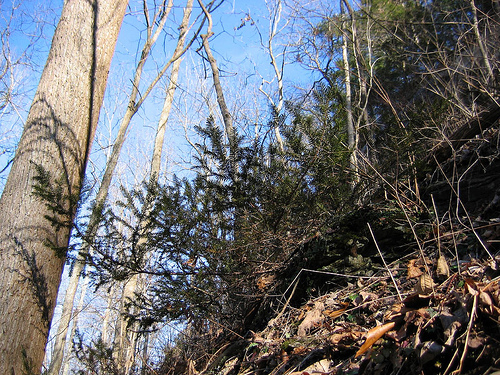
Taxus canadensis, rare Kentucky native plant, Carter
County
(*photo
credit)
No one likes noise, at least some forms of it. The classical
music lover may flee from the hard rock band. But so will the
hard rock lover flee from an argumentative household with its
abusive language and loud voices. What is evident is that all
people attempt to flee when that is possible and corrective measures
are impossible, because some sounds are uncomfortable.
Loud unwelcome noise.
In an age of traffic noise and sirens, leaf blowers and jack
hammers, motorcycles and jet skis, airplanes overhead, and blaring
radios and televisions, we are often unable to flee too far, for the
air waves are filled with sounds from so many amplified sources.
Modern technology seems to trumpet the success of filling in and
defeating silence with so-called gratifying noise. Some of
this we must endure because it is part of our work. The
clanging and roar of industrial machines have been endured
throughout the industrial revolution and are regarded as part of the
price of a living wage. Over time social progressives pressed
for the reduction of these noises, and so noise pollution standards
were enacted and enforced in many major industries. There are
decibel limits for periods of time, and certain protective measures
are required for those who must work close to noisy sources.
Background noise.
Discounting the terrible toll that loud noises do to our ears,
especially those of higher decibel levels and at close proximity,
what do unwanted noises at a greater distance do over time? We
may boast that we can endure the urban sounds around us and pride
ourselves on not being startled and frightened like others who are
unfamiliar with these particular sounds. But the impact of
incessant noise is to fray our nerves, increase the stress on our
hearts, and impair our learning abilities. Studies show that
students of similar age groups do better in quieter surroundings.
Noise hurts most of us and reduces our attention span. Noise
leads to family disturbances and social unrest, and makes for a less
enjoyable environment. Noise reduces the quality of our lives
even when we would never admit it.
Lack of silence.
If major noises startle us and harm our auditory senses, and
insistent background noises reduce the quality of our lives, what
does the absence of silence do to us? We may overlook
this third aspect of noise pollution for a simple reason -- the
chatter that we generate seems to be a replacement for loud or
background noises and thus a welcome relief. However, the
persistent sounds still seem to fill the waking -- and sometimes
sleeping -- periods of life. For some, especially those who
are immersed in continual background noise, moments of silence are
frightening. People become so accustomed to noise that they
say they are uncomfortable with silence. To be alone is
equated with silence and that enters into the lurking concept of
death. Few value the moment of silence, the time to find God,
the opportunity for inner reflection, the chance to come to know
oneself. And this is part of the terrible toll of noise
pollution.
May 24, 2007
Noise
Sensitivity
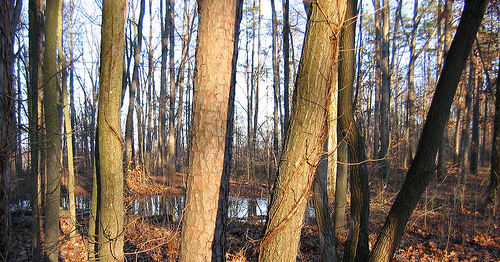
Vernal pond, Tygart State Forest
(*photo
credit)
During noise awareness
week, we need to consider the fact that everyone should develop a
sensitivity to noise and to the need for sound punctuated with times
of silence. This twofold aspect to noise sensitivity is like
appreciation of good music -- for that is part of the harmony found
in the life of activity and rest. What is important is that we
recognize and cultivate that sensitivity and understand that it
reaches beyond the individual and personal and involves both
reducing noise (tomorrow's reflection) and creating silent space
(the day after tomorrow's reflection).
Granted, some people are
more sensitive to noise than others. That could be due to any
number of reasons: very delicate auditory senses that are affected
by discordant sounds; the lack of proper rest and a realization that
activity must be coupled with silent time and space; pressure to
produce results and an inability to concentrate due to noise; an
awareness of having suffered or knowing someone who has suffered
hearing loss resulting from excessive noise; a sentimental longing
for a quieter period of life; or a distaste for certain forms of
urban noise or modern music and their aftereffects.
It may be argued that this
sensitivity is a natural protective mechanism for all of us, and
that people normally seek harmony in life even when some feel
powerless to bring about this needed situation. One recourse is to
flee from the noise source and thus regain the precious time and
space needed to harmonize one's life. Another is to say nothing
about noise hoping that one can learn to adjust and cope with the
assaults present. There is often an intimidation by those who make
the noise as though that is part of their freedom of speech, and
those who question such an exercise are simply out of touch with the
times.
With time, people acquire a
deeper sensitivity and are able to judge when noises are too loud.
This may involve operating a standard noise meter or coming to an
estimation of the degree of the noise impact. People gain good
judgment as to where noises originate and who is the source. At
this stage the sensitive person can withdraw and hide or run, or
remain silent through lack of boldness. On the other hand, a
mounting sensitivity could make one an activist who seeks to address
the causes, who takes time to reduce noise that is under his or her
control, and who will use forms of creativity to expand the areas
and times of silence in one's life and that of the community.
In this last level of
sensitivity to noise we need to first pinpoint carefully the sources
of noise, quiet down our immediate surroundings, and then move out
to the wider community which needs to address noise and silent
zones. Insensitivity is the fruit of noise-making and
self-centeredness; sensitivity is the fruit of awareness, boldness
and creative efforts to reduce existing noise and create silent and
harmonious alternatives.
May 25, 2007 Ten Ways to
Reduce Noise
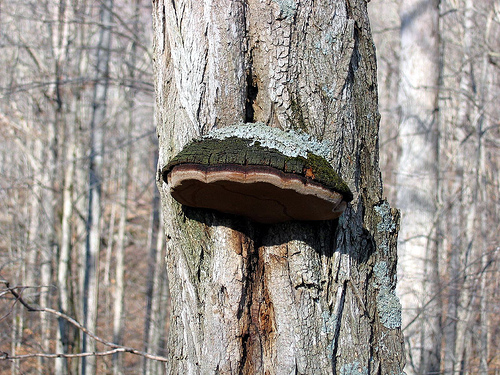
Bract (fungus) on tree
(*photo
credit)
Each of us can contribute
to reducing the amount of noise in the world around us. Perhaps you
are looking for ways to communicate your concern to noisy people
around you, provided you are not aggressively assaulted in your
noble attempts. Here are some sample actions:
1. Turn down the volume.
We are all becoming a little more deaf and so we turn up the volume
to hear better, but that can create a noise problem for others
around us. We are not just to become sensitive to noise ourselves,
but to what affects others and whether our own practices interfere.
2. Consider the use of head
phones. When wanting to listen to music or discussion that others
would find irritating, personal head phones may prove to be a
welcome answer.
3. Get rid of snow blowers
and leaf blowers. There are few things so noisy and so easily
replaced by muscle and good exercise.
4. Do the same for noisy
hair dryers and the like.
5. Can the grass mowing be
done with a muscle-powered mower?
Most often it is the people who
need the exercise who go out on weekday or Saturday evenings to mow
the lawn while riding about seated on a power mower. Really these
often overweight specimens are fooling themselves if they think they
are getting more than some fresh air and sunlight. Even if someone
objects to the exertion, the push mower gives exercise and saves
fuel all at the same time. Many modern hand mowers are quite easy
to maneuver, but the secret is not to let the grass get too long.
Also think about turning hard-to-mow spaces into wildscape.
6. Turn lawn into wildscape
and thus avoid mowing.
7. Strive to limit cell
phone use. This advice can be expected from someone such as myself
who sees little use for such devices except in a 911 emergency
situation. If the person beside you is incessantly talking on the
cell phone, either muster the courage to convey your annoyance or,
if possible, move elsewhere. Often cell phone users speak loudly.
If they are driving and calling you, tell them you must hang up and
not risk their safety and that of others on the road.
8. Switch to soft music.
9. Reduce the volume of
doorbells, home phones, timers for the microwave, safety and fire
alarms, clock alarms, and the radio. Turn off the tv when not
watched. And what else can be turned off?
10. Support community
efforts at noise regulations such as curfews, limits to motorcycles
and ATVs, times for lawn mowing and leaf blowing, and limits on the
use of motor boats and jet skis.
May 26, 2007 Ten Ways to
Create Silent Space
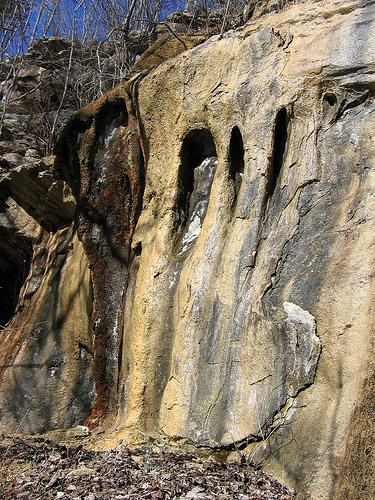
Travertine on Limestone, Carter Caves State Park
(*photo
credit)
As said previously, noise
pollution needs to be attacked on several fronts simultaneously. At
the very time we focus attention on reducing discordant and loud
noises, we should be thinking up ways to create silent space within
ourselves, within a household, in our times of day, week, month,
year or longer, and within the local community.
1. Create silent space
within yourself (see "Praying from the Heart: Sacred Space," March
11, 2004).
2. Allot silence space
within the home especially when residents have different tastes and
habits. Fix a quiet room with its own acoustical materials for
those who wish to listen to something while others prefer to remain
in silence. Even egg cartons tastefully dyed and arranged can be
low-cost materials for quieting the special room or nook.
3. Take rest breaks during
the work day to gain strength and energy to keep on top of the
assignments at hand.
4. Sleep should be in a
silent place where one is undisturbed.
5. The Sabbath rest is
quite important in our lives. Take off on the day of rest and truly
do something that is restful. Remember, it is also a day of prayer.
6. Create some sacred
space in your life, a place where with minimal noise the different
senses can harmonize with the sights, sounds, smells, tastes and
feelings of nature. Visit this space when the need calls.
7. An annual retreat is a
time to ask questions about the way your life is going. It is
important that this be made in a quiet setting where you can focus
on your life in a meaningful manner.
8. A vacation is a time for
relaxation and some quiet time. A trip that involves busy airports,
noisy cities, crowds of tourists, and much highway travel is hardly
the silent space that is needed to recoup and regain and strengthen
one's interior harmony and well being.
9. Where noise is a major
factor, some forms of sound barrier are possible either for the
individual property or for a larger residential community. These
vary in type of material, degree of maintenance, height, and manner
of construction.
10. Make sure hospitals and
other institutions are designated as quiet zones in your community
and that the regulations are enforced. When development plans call
for zoning changes, ensure that noise pollution is considered.
May 27, 2007
A Time to be
Silent
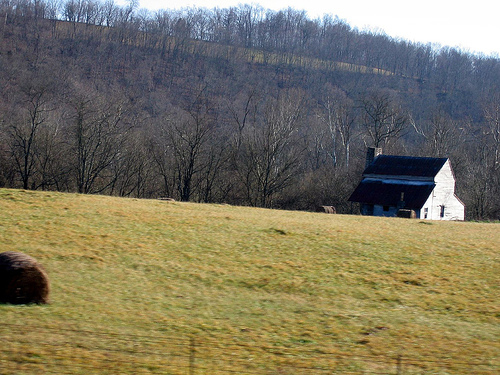
Old farmhouse, Rowan County, Kentucky
(*photo
credit)
There is a time for
everything under heaven, even on the feast of Pentecost when the
disciples burst forth full of spiritual energy and preached to the
crowds outside. Each heard the message in his own language and thus
the gift of tongues was manifest to the crowds and to the whole
world. If such is the wind and fury of Pentecost, why talk about
silence on a day like this? Pentecost is a season of proclaiming
Good News - not of being wordless.
To say there is this time
to speak does not mean we chatter incessantly like cell phone users
bent on constant communication with other unfortunate souls who are
equally compulsive. Both parties need periods of silent time. What
we have been saying throughout this past week is that there are
times to speak and times to be silent -- and a peaceful and
harmonized person knows when to do each. A disturbed soul has a
compulsion to speak when all has already been said.
Silence may be called
for. Jesus taught
his disciples at length and the crowds who came to hear his
message. He called Herod a fox, then when Jesus was brought to him
at the time of trial before the Calvary event, he remained silent.
Do we find this surprising? It was not a time to say things in
one's own defense, and Jesus' entire teaching mission involved
speaking the truth, although he did steal away for evenings of
silence with his Father. But Jesus did not waste his words before
one who only wanted to ridicule him. In such a case silence was and
is golden.
Silence can be
political. Pentecost
impels us to spread the Good News. Yes, at times we must speak, and
to remain silent when we must speak is itself taking a political
side. Silence when we ought to speak is to shirking a citizen
responsibility; this speechlessness has no place in the life of
those who receive the gifts of the Holy Spirit and, like the
disciples, are to carry the message to public places.
Silence is needed when
we must listen. The
impulse may be to spout out words, but there are times when we need
to hear what others have to say so that we can gain some knowledge
of a situation. Here our silence is deliberate and active.
Some remain silent in
order to allow others to speak on their behalf.
There are times when we must encourage others to speak on our
behalf. We must do so because some are impulsively desirous to
present the views of others even when those people may be able to
say something more meaningful on a given subject. Allowing others
to speak is part of being a team or "church." Their gifts must also
be encouraged. Have we ever heard two or more of the active types
trying to compete with others in a news event? Actually we hear
neither. Let one speak for the rest and, even though the silent one
could say it differently, let it be so. If a corrective is called
for, let's hope this can be done with kindness and good will. There
is a moment for everything under heaven.
May 28, 2007
Memorial Day
and Memories

Tombstone from 1860. Downing Family Cemetery. Lexington,
Kentucky
(*photo
credit)
On one day a year we should
give special remembrance to the many who have done so much in our
own lives and have also passed on to the Lord. We often consider
Memorial Day as a holiday and forget its serious side. Or we
remember some people and forget the rest of those we ought to
remember.
Military remembrances
-- It is generally a day to remember the fighting men and women who
defended our country. And there are good reasons for being
respectful. Not all the wars of our past are remembered with
devotion but some are valued and should appreciate the spirit and
willingness of the often-young warriors, no matter what we think of
the current war.
Family remembrances --
Our feeble memories should not forget our own families, and that is
why we often couple Decoration Day with Memorial Day -- a time to
remember relatives who have gone before us and whose names and
important dates are found on tomb stones in the family cemetery. We
say a special prayer for their souls and recall important events in
their lives. So often, we know little about our ancestors beyond
two or so generations. With all the tools now available (Internet
information, national census data, etc,) we are more able to extend
that knowledge and share it with others in the family.
Friend remembrances --
As we advance in age, more and more of the friends that we knew in
youth, or at various times in life, pass on to the next world. We
remain, separated from the company that included these noble souls.
Today, on this holiday, friends also should be remembered in
prayers and a toast. Perhaps we could resolve to send a note of
remembrance to their spouse or other loved ones.
Neighbor remembrances
-- Expanding our remembrances to the neighborhood will incorporate
the acquaintances who were not really special friends but have died
this past year. We realize that their next of kin are finding today
to be a bittersweet holiday, and our special remembrances in the
form of a greeting or phone call would be deeply appreciated by
those who grieve.
Educator remembrances
-- Others who do not fit into any of the above four categories go
back in time many years for adults and especially seniors -- and
memories are becoming faded. Today at the time of graduations and
commencements we also remember that the educators of our past put up
with much to shape us into who we are. They also deserve a special
remembrance even when we do not fully remember all of them or their
particular names. Let us accept one fact that our memories are
getting rusty and trust that the Lord knows our good intentions and
extends to them the blessings that we now give.
May 29, 2007
Globish:
Going Half Way
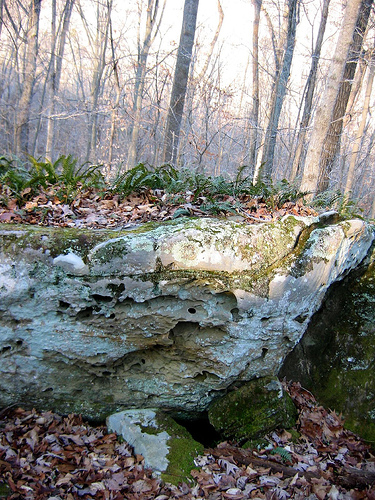
Honeycomb appearance of the Corbin Sandstone
(*photo
credit)
In the December 22, 2006,
issue of the Guardian Weekly, Robert McCrum discusses what is
termed "Globish-English-lite;" this he states, is becoming the
universal language of the business world. This is not "pidgin" or a
broken English used by the unlearned in some parts of the world, but
rather the language that non-Anglophone business-persons speak among
themselves. This language conceived by Jean-Paul Nerriere is
regarded as a "world dialect of the third millennium;" it is
simplified and unidiomatic and is called "Globish." This English-lite
1,500-word vocabulary resembles what I.A. Richards did with 850-word
"Basic English" for use in China in the 1920s. Another attempt was
"Anglic," but this lacked the use of English words in their common
spelling, looks terribly unfamiliar to many, and is a chore for
English speakers to spell.
I liked the concept of
basic English but found it quite incomplete even when idioms used
were based on the chosen words. I have toyed with the idea of just
what these people are doing -- simplifying English and encouraging
native English-users to remain within the limits especially when
speaking with non-Anglophones. It would be so much better if we were
to limit our language so that others who are not native English
speakers could communicate more easily. And of course we ought to
slow down when speaking. Why must all the burden of speaking in our
nuanced and complex language rest with others? Let's keep words
basic and simple for maximum understanding.
Interestingly, I have
worked as a hobby on a basic English for years and have a number of
versions. The current one that will appear in our Special Issues in
a short while will be a little more nuanced than a mere listing of
1,500 words. My listing of 1,500 basic-Globish words is drawn from
various listings and includes all words that have been added to and
omitted from the original Globish listing. A secondary listing of
some added American words would be of interest when people are
visiting our country (foods, governmental terms, etc.). A regional
listing could follow at a later date with names of plants and
animals.
What is my hope? It is
very big one, namely, to use only "basic Globish" in these
reflections. Some will say that it will be a deliberate "straightjacketing"
of the subjects that are being addressed. That is why it will take
some time to select those words that prove most necessary and to
decide which to omit. Our normal vocabulary is about ten thousand
words with numerous occasional exceptions when discussing one or
another technical subject. One approach is to use more than the
basic words, but to define the additional words by using basic
ones. I am expressing a future goal and for the benefit of a wide
variety of people who read these reflections and consider English as
a second language (we had readers from ninety-four countries last
month). May this become a correct manner of speaking in a company
of non-English-speaking people. Why not go half way?
May 30, 2007
The Gifts of
the Holy Spirit

Point of
contact: Sandstone over Limestone at Cascade Caverns
(*photo
credit)
...And you will receive the
gift of the Holy Spirit. (Acts 2:38)
On the feast of Joan of
Arc, a very gifted young French maiden, we could start a Pentecost
season set of reflections (in June) on the gifts of the Holy Spirit
in our own lives.
A shoot springs from the
stock of Jesse,
a scion thrusts from his
roots:
on him the spirit of
Yahweh rests,
a spirit of wisdom and
insight,
a spirit of counsel and
power,
a spirit of knowledge and
fear of Yahweh.
(The fear of Yahweh is his
breath.) (Isaiah 11:1-2)
Ordinarily we consider the
gifts of the Holy Spirit as personal gifts meant for our individual
sanctification; they make us open to be disposed and inspired by
the Spirit in our journey of faith. The community of believers also
recognized another area of gifts, that of the "charismata," the
extraordinary favors, granted for the help of another (I Cor. 12:
6-11; I Cor. 12: 28-31; Rom. 12: 6-8) such as the speaking in
tongues. However these two sets of gifts are closely associated.
Sanctification is more than
a purely private relationship between God and me; it involves a
communal dimension, wherein the seven gifts of the Holy Spirit are
shared in some way with our neighbor through example and
encouragement for their benefit and spiritual growth. Thus
sanctification is a communal and even a global enterprise, for it
must be truly "catholic" in outreach -- a building up of the Kingdom
of God of which we are catalysts in our own way.
Roman Rite
Prayer at Confirmation
All powerful God,
Father of our Lord Jesus Christ,
by water and the Holy
Spirit
you freed your sons and
daughters from sin
and gave them new life.
Send your Holy Spirit
upon them
to be their helper and
guide.
Give them the spirit of
wisdom and understanding,
the spirit of right
judgment and courage,
the spirit of knowledge
and reverence.
Fill them with the
spirit of wonder and awe in your presence.
We ask this through
Christ our Lord.
The gifts of the Holy
Spirit may be applied in a very real sense to our ongoing
relationships with others within our community of faith. The long
six-month season of Pentecost that ends the first of December is the
time when we seek to improve our practice of these gifts. During
this span of time we ought to reflect on the seven gifts and make
them part of our everyday life.
May 31, 2007 Public
Citizen Health Research Group
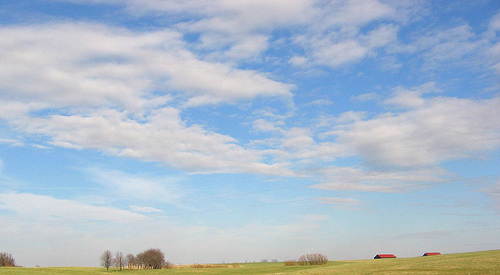
Bluegrass skies, blue sky above expansive green field.
(*photo
credit)
The organization that we
will give special attention to this month is the Public Citizen
Health Research Group. This public interest organization was
founded by Ralph Nader and Sidney Wolfe, a medical doctor, in 1971
and has the purpose of fighting for the public's health, and giving
consumers more control over decisions that affect their health.
Besides a series of
actions, alerts, testimonies, and other public interest activities,
the group has reached the public through a series of books and
newsletters. Its book, Worst Pills, Best Pills has sold over
2.3 million copies in the past few years and can be ordered at <www.citizen.org/HLFEB7>
The group's February
"Health Letter" contains the following articles:
* Medicaid @ 40: Why
It Matters
* Work and Wellness:
Collusion or Collision?
* FDA Should Not
Seek More Drug Company Money, Should Get All Funding from U.S.
Treasury
* Conflicts of
Interest: An Issue That Will Not Go Away
* Product Recalls --
Drugs or Supplements -- Consumer Products (27 ranging from all
terrain vehicles to strollers
* Conflicts of
Interest Among Clinical Investigators
* Essay: What's
Making Us Sick Is an Epidemic of Diagnoses (reprint from January 2,
2007) New York Times
A reader might be tempted
to think this material is directed at health care professionals.
However the subject, the content and the style will all appeal to a
wide variety of concerned citizens. Health affects us all and, if
the pill-pushers and others are right, over half of us suffer from
the "medicalization" of everyday life where insomnia and sadness
become sleep disorder and depression -- and on and on. We Americans
suffer from the highest health care costs in the world, but we are
not the most healthy by any means. We all need to help control
these costs before they overwhelm us, and we all need to use more
common sense to protect our individual and group health and safety.
The Health Research Group has been nobly attempting to do just that
through the past thirty-six years.
Address: Public
Citizen Health Research Group
1600 20th
Street, N.W.
Washington, DC 20009
<www.citizen.org/hrg>
|